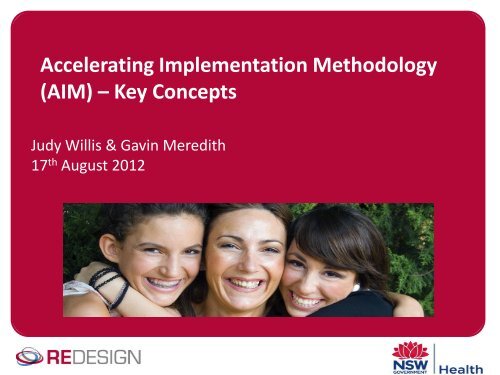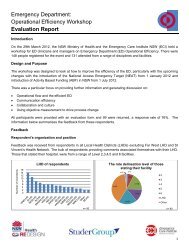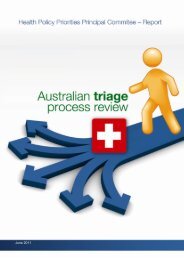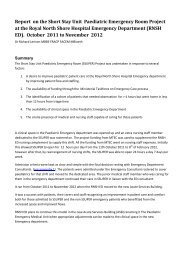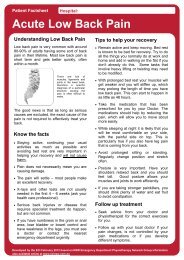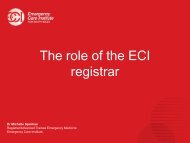AIM Accelerating Implementation Methodology - Emergency Care ...
AIM Accelerating Implementation Methodology - Emergency Care ...
AIM Accelerating Implementation Methodology - Emergency Care ...
You also want an ePaper? Increase the reach of your titles
YUMPU automatically turns print PDFs into web optimized ePapers that Google loves.
<strong>Accelerating</strong> <strong>Implementation</strong> <strong>Methodology</strong>(<strong>AIM</strong>) – Key ConceptsJudy Willis & Gavin Meredith17 th August 2012
Introduction to <strong>AIM</strong><strong>Accelerating</strong> <strong>Implementation</strong> <strong>Methodology</strong>Objectives:• To briefly introduce the elements of <strong>AIM</strong> to the group• To provide the group with strategies to use throughoutthe project which will assist with <strong>Implementation</strong>.
PERFORMANCE & PRODUCTIVITYSYSTEM DEVELOPMENT CYCLEHUMAN DEVELOPMENT CYCLEFuture StateAnalysis • Design • Development • Testing • TrainingCompetencyDevelopmentPerformance• CoachingReinforcement• Management• RetrainingProject ROIGo Live Cut OverINSTALLATIONTIMEIMPLEMENTATION
Minor Change – Minor DisruptionMinor alterations to the Frame of Reference resulting in minimaldisruption and resistance, like a change in policy or procedure1 ST Order – Frame- BendingMajor alterations to the existing Frame of Reference resulting insignificant resistance. Taking what you are currently doing and doing itbetter. Multiple sets of improvements around something that currentlyexists2nd Order – Frame- BreakingThe old Frame of reference is no longer adequate. A new FOR must becreated resulting in maximum disruption and resistance – requires theold FOR to be broken down. The organisation must “forget what theyare doing now.”
Introduction to the <strong>AIM</strong> Road Map“By failing to prepare, you are preparing to fail…”-Benjamin Franklin10. PrioritizeAction1. Define theChange2. BuildAgentCapacity9. CreateCultural Fit3. Assess theClimate8. DevelopReinforcement Strategy4. GenerateSponsorship7.Communication Plan6. DevelopTargetReadiness5. DetermineChangeApproach
Cast of CharactersChampionsIndividuals who believe in and want the change and attempt to obtaincommitment and resources for it, but lack sponsorship to drive it.<strong>Implementation</strong> can be accelerated when the other three roles are alsoChampions.AgentsImplement change. Agents have implementation responsibility through planning andexecuting implementation. At least part, if not all, of their performance is evaluatedand reinforced on the success of this implementation.SponsorsTargetsAuthorise, legitimise and demonstrate ownership for the change: possesssufficient organisational power and/or influence to either initiate resourcecommitment (Authorising Sponsor) or reinforce the change at the local level(Reinforcing Sponsor).Change behaviour, processes, knowledge, perceptions, etcRef: P23
Define the change• What are you changing?• Why are you changing it?• What are the consequences of not changing?• Needs to be specific and measurable• There must be clear and commonly held definitionof the present state and the desired state forsuccessful implementation
Build agent capacity• Key skills & attributes for an Agent– Trust & credibility– Successful organisational history– Belief in the project– Translate FOR of targets & sponsors• Agents job– Communicate– Educate– Facilitate• Can’t do it all alone..may need to enlist others
Assess the Climate• Identify implementation strengths & weaknesses• What’s gone on before in the organisation– Adverse publicity– Restructure• What other changes are going on in theorganisation that will impact on your project?
Generate Sponsorship• Sponsorship is the single most important factor forsuccessful implementation• Express, Modelled & Reinforce• Agents need to:– Educate their sponsor– Contract with their sponsor ( If you want.... I need....)– Preserve their sponsor’s currency (time, money, energy &reputation)– Identify all sponsors & targets in the project
Determine Change approach• Change – symbolic ending of the present state• Is it for compliance? HammerEndPRESENTSTATEBeginningDESIREDSTATETransitionTRANSITIONSTATE• Is it for commitment? TransitionEnd Transition BeginningProductivity/MoralePRESENTSTATETRANSITIONSTATEDESIREDSTATE• Need to identify the frame of reference
Develop Target Readiness• Resistance is a process that must be managed. Itcannot be combated, solved or overcome.• Resistance can be good or bad• Find out the “What’s in it for me?”• Use of 2 good faith attempts– Listen to feedback– Demonstrate that you listened– Acknowledge their pain but don’t defend– Problem solving – brainstorming some ideas
Communication• Right message to the right people using the rightvehicle.• Communicate in the targets frame of reference• Use the “What’s in it for me?”/ Frame of reference• Resources up your sleeve 1:3:25• Face to face has the most impact• Check all your communication forsanity
Develop a reinforcement strategy• Reinforcement strategy– Reward – align with FOR– Consequences – Immediate & certain– Effort – new way easier, old way harder
Create cultural fit• Culture- What is it?– Unwritten rules– Behaviours– values• Align the change with the Culture• If your project conflicts directly with the culture,culture wins
<strong>AIM</strong> Concepts – Prioritise Action• Putting it altogether10. PrioritizeAction1. Define theChange2. BuildAgentCapacity9. CreateCultural Fit3. Assess theClimate8. DevelopReinforcement Strategy4. GenerateSponsorship7.Communication Plan6. DevelopTargetReadiness5. DetermineChangeApproach
On line learning - GemWhere to find Gem:https://gem.workstar.com.au<strong>AIM</strong> is located at the e-learning tab under implementationMany other topics relating to project management are available
More Information:• Judy WillisPrincipal Policy Advisor - Surgery | System Relationships & FrameworksTel 02 9391 9557 | Fax 02 9391 9456 | Mob 0458 713 435 | juwil@doh.health.nsw.gov.au• Gavin MeredithCritical <strong>Care</strong> and Surgery Taskforces Manager (CCST Manager).| Agency for Clinical InnovationTel. 02 8644 2183| Fax. 02 8644 2151 |Mob. 0467 749 714 | Gavin.Meredith@aci.health.nsw.gov.au• Vanessa EvansManager | <strong>Emergency</strong> <strong>Care</strong> InstituteTel 02 8644 2166 | Fax 02 8644 2148 | Mob 0403 497 654 | vanessa.evans@aci.health.nsw.gov.au• Sophie BaughManager - Special Projects| <strong>Emergency</strong> <strong>Care</strong> InstituteTel 02 8644 2152 | Fax 02 8644 2148 | Mob 0467 710 667 | sophie.baugh@aci.health.nsw.gov.au• Lea KirkwoodProgram Manager - Centre for Healthcare RedesignTel 02 9424 5806| lea.kirkwood@aci.health.nsw.gov.au


